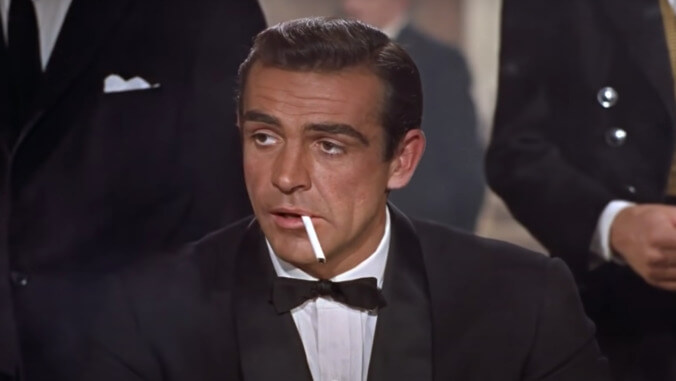The caricatured version of James Bond that has permeated pop culture is that of a debonair, shaken-not-stirred-martini-drinking Casanova who may get into a tight jam, but will always find a way out. That’s the image of 007 that I’ve had, because everything associated with the character has become so codified that it’s been parodied in Austin Powers and on The Simpsons and a hundred other places. These Bond tributes, take-offs, and ripoffs are the only impressions I had of this 61-year-old series because until about a week ago, I had a pretty baseline knowledge of the franchise.
So I recently assigned myself a personal quest to fill the gaping hole in my brain where James Bond knowledge is supposed to go. Previously, I had seen two Bond DVDs that my dad had when I was a kid: Diamonds Are Forever, because I knew the theme song, and Octopussy, because I thought the name was funny when I was in eighth grade. (And still do. It’s funny.) I remember effectively nothing about these movies, so for all intents and purposes, I’ve started from scratch with 1962’s Dr. No.
Dr. No (1962) “One Million Dollars, Mr. Bond”
The plot finds Connery’s Bond mostly stationed in Jamaica—a British colony when the movie was filmed, but an independent nation when it was released. When an MI6 agent and his secretary are murdered on the island, 007 is dispatched to figure out what is going on. Essentially, the mysterious Dr. No (Joseph Wiseman) is attempting to block the launch of Project Mercury from Cape Canaveral by using radio signals. The technology is powered by a nuclear reactor, which eventually brings Dr. No to his end.
Look, I’m not going to pretend like I thoroughly understand the science at play here. The film itself seems largely uninterested in explaining how this works, which is for the best. Dr. No is a product of the early Cold War era, and explicitly plays on the anxieties of the time. Your average British or American theatergoer in 1962 didn’t need to fully understand how nukes or rockets work to know that they were afraid of them. Why get bogged down in details?
The geopolitics, which are also barely alluded to, are notable. The people already in Jamaica are treated as disposable, and pretty much everyone who crosses paths with Bond, whether friend or foe, winds up dead. Most disappointing is Quarrel, a local who assists Bond on the case. He is unceremoniously flame-throwered to death by a roving, mechanical dragon. In the film’s conclusion, Bond wins by destroying a nuclear reactor on Crab Key. The island is destroyed and the whole area will be contaminated for generations, but the CIA will be able to launch their rocket. Yay!
I don’t want to take the science to task too badly. This was way pre-Chernobyl and the ramifications of something like this would have been pretty abstract to the general public and, probably, a decent segment of the people working on the film. That’s the generous explanation. A less generous one is that Britain was about to lose control of Jamaica and didn’t care what happened to an island full of non-white people. Regardless of the intention behind it, it’s one of those things that in hindsight you see and tug on your collar a little bit. (As an aside, in Ian Fleming’s original novel, Dr. No runs a guano mine, an operation that actually was fairly prolific in the 19th century and kinda-sorta started the United States’ own imperialism. Geopolitics is weird.)
Connery’s Bond: Cool, and completely confident
What I am willing to take to task is the fact that multiple Asian characters, including the titular Dr. No, are played by white actors in yellowface. It was unfortunately common in Hollywood to do this—hell, How I Met Your Mother did it in 2014—but it’s still an uncomfortable watch. It was just as wrong then as it is now. A small saving grace, if there must be one, is that neither Wiseman nor Marshall leans into a stereotypically Asian portrayal, instead being simply hammy in a Bond-esque way.
The stuff that works best in Dr. No is the stuff that indulges in the camp of the situation. Connery in particular is not what I expected from a first watch—he was better. Yes, he’s debonair and sexy, but he is also so remarkably unperturbed by the frankly insane events unfolding around him. The iconic image of him, eyebrow slightly raised and cigarette dangling from his mouth isn’t simply an image but an attitude. Bond isn’t the definition of cool because everything goes his way, but because he’s completely confident that everything will end his way.
Ultimately, it did. The legacy of this debut is what makes Dr. No successful, if as an artifact more than a standalone film. And it’s the goofiness of this film and the character that I’ve realized is just as influential as Bond’s suaveness. It’s part of the reason the parodies have also proliferated to such an extent. Audiences in 1962 may not have had the most robust knowledge of nuclear politics, but they were smart enough to know when something was goofy. I think that’s why you can still mostly get the gist from watching Austin Powers. But there’s only one place you can get Sean Connery, and it’s right here.









































